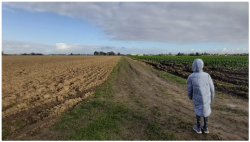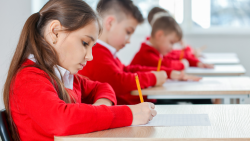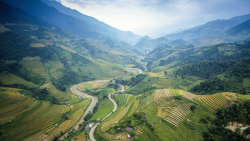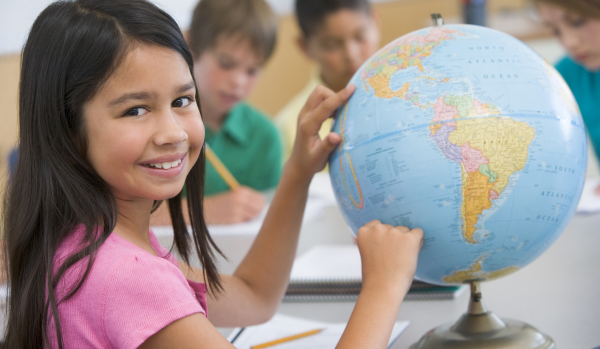
We all have the subject or subjects in the primary curriculum which are our ‘favourites’, perhaps because we studied them at university or because they reflect a personal interest or hobby such as aspects of PE or the arts.
Geography is one of mine, despite having absolutely no sense of direction. (If I’ve worked in your school, you have probably found me wandering aimlessly around the corridors at some point searching for the clearly signed KS2 classrooms or the exit at some point. I can only apologise but at least I found your school. Thanks Satnav.)
I have taught the subject from EYFS to Y13 at some stage many years ago, albeit with no claims of having taught it particularly effectively especially at Secondary level. I quickly went back to Primary and stayed there for the rest of my teaching and leadership career.
As we know from the research review and other evidence geography is often the poor relation when compared to its illustrious humanities counterpart, history.
One of the benefits of my role now (aside from sparing KS4 students my attempts at teaching) is visiting Primary schools all over the country and seeing great ideas and practice, so here in no particular order are some of the most effective geographical tips and ideas I have encountered recently, which might be useful to share with the subject leader and teachers.
Geography Tips and Ideas
- Making sure fieldwork is taught properly. In some schools it does not take place at all, or if it does it is a traffic survey which is actually a vehicle (no pun intended) for maths, with no geographical content. Good ideas can be found online including here from the Royal Geographical Society.
- Promoting geography as a subject in its own right and making sure pupils (and all teachers) know what it is. Some schools have found through pupil voice that the pupils know what history is as a subject and can talk about their learning, but not so much in geography. This is often a reflection of how the subject is promoted and how disciplinary knowledge is taught, or in some cases not taught. Below is a display from a school that ‘re-launched’ geography through staff CPD, a revision of the planning and a dedicated reading area for geographical books in the library. This was followed up with staff sharing best practice, reflection and subject leader monitoring.
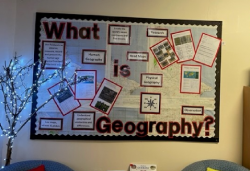
- Putting ‘You are here’ arrows on every map! Having realised that many pupils did not have that locational knowledge of where in the country and world they actually lived, in one school this arrowing was introduced on class maps, on the world map in the corridor and on any relevant map work. This then established that knowledge and reinforced it in relation to other places that were studied.
- Introducing geography workstations. A school that is fortunate to have space in KS2 classes has shared ideas for these workstations to replicate the similar display spaces that are often dedicated to history with artefacts and are far more common in primary schools. This helps redress the imbalance between the two subjects in terms of their prominence in the classroom and in teaching, and really enthuses the pupils.
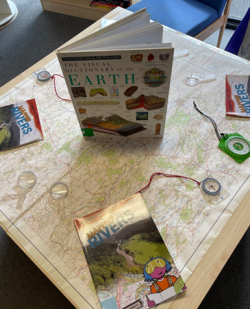
- The use of webcams and online resources to ‘take’ the pupils to other places. As a legacy of covid restrictions a number of schools have looked at providing virtual trips and visits, especially when pupils do not have first hand experiences of a beach, mountains, a harbour or the various other location that might be referred to in lessons. Google have their virtual field trips and Skyline webcams are a useful starting point for visiting parts of the world in real time. We ended up watching the elephants visiting the Kenyan watering hole during the coffee break on one of my most recent training days, with a collective “Awww!” from delegates when the baby elephant ran into view, ears flapping furiously. I have also used that one myself with EY children with the children replicating the watering hole in the outdoor area and sorting the animals to take there, building the safari jeep with construction kit and binoculars from kitchen rolls.
- Make sure subject leaders who work in KS1 and KS2 know the children do learn a tremendous amount of geography in EYFS. I know it is obvious, but I did have one subject leader who was a Y5 teacher once say to me “But they don’t do geography in Early Years do they?”. I know other geography subject leaders who have already planned to visit The People’s Independent Republic of Early Years in their respective schools this term to gain that overview across the whole setting and discuss starting points with EYFS colleagues. Get a trip in the diary!
Tim has been a headteacher with a successful track record; his last school had a reputation for innovation and their initiatives have been utilised by others and presented internationally.
School improvement has been at the heart of his career, working as an LLE, a School Improvement Partner, Professional Partner as well as an Ofsted inspector and mentor for trainee inspectors.


